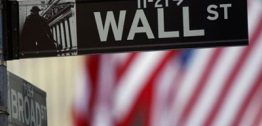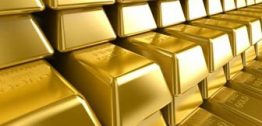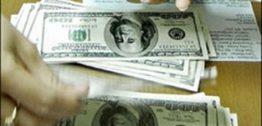Trumped!
Here’s what it means to you, including updates on the U.S. bond markets … the U.S dollar … the Dow Industrials … gold, silver and more. Plus, your questions and my answers.
Wow, what an election. What a month so far. What a shocking surprise to the majority of pundits and analysts on and off Wall Street, not to mention voters and investors, all over the world.
Yet, as I’ve explained before, it’s all been written in stone, right from the beginning. From the beginning of time, you might even say.
Not that it matters all that much — even if Hillary had won. Our country, following on the heels of Europe and then Japan, is headed toward a five-year roller-coaster ride through hell.
So if you think the absolutely wild market gyrations that occurred in the wake of these elections were simply one-off reactions to the unexpected …
Think again. Market volatility is going to increase dramatically in the weeks, months and years ahead … because the great sovereign debt crisis, perhaps the worst of all time, is now out in the wide open.
How do I know? Simple. Consider the asset class that got hurt the most immediately after the election: U.S. Treasury notes and bonds.
The 30-year U.S. T-bond price collapsed nearly 10 points in just three days … with the yield, in turn, jumping from 2.518 percent to 2.958 percent. I repeat, in just three days!
Moreover, since July the long bond yield has surged from 2.088 percent to a recent high of 2.958 percent (a 42 percent increase in yield) …
While the 10-year note price has lost more than 4-points since July and seen a 75 percent jump in yield from 1.318 on July 6 to 2.301 on November 14.
What kind of losses are these in dollar terms for holders of U.S. notes and bonds?
Roughly a $17,940 loss in the 30-year bond and a $24,590 loss in the average 10-year note (based on a $100k face value bond).
Now you know why I said to stay away from U.S. government debt all along!
What Triggered the Massive Bond Market Selling?
I have no concrete evidence yet, but my overseas sources tell me the sellers were largely foreign governments and central banks.
Why would they sell? Simple …
- Our national debt of nearly $20 trillion is going to explode higher. Trump will spend trillions more. And so would’ve Hillary. Plus, as interest rates rise (and bond prices fall as they are now doing), they compound the interest expense portion of our debt. That too is bad news.
- Perhaps more importantly, foreign governments and central banks are now deeply concerned about President-elect Trump’s trade stance. And rightfully so.
If he follows through and labels China a currency manipulator and slaps tariffs on its exports to our country and on the likes of other exporters like Japan, Mexico and others …
They’re going to pull the trigger first, and start dumping their holdings of our Treasuries. They will stop financing us. And that is exactly what they’re already starting to do. Sending the message.
Lest you think it would have been any different if Hillary had won, think again: Her policy of raising taxes and spending more would have killed our economy and blown our debt out even further.
Plus, what leaked out about all the scandals involving her — the emails and the Clinton Foundation conflicts … would have caused our foreign creditors to lose confidence, and the collapse in the bond market would still unfold.
But Don’t Look at the Bond Collapse in Isolation. Also Consider the Market It Sent Soaring.
As bonds were literally crashing in the aftermath of the election, the Dow Jones Industrials soared to new record highs, blowing out the major overhead resistance I pegged, and which held for more than a year, at the 18,500 level.
Bonds down, stocks up — precisely what I’ve been telling you all along would happen. And that rising rates could not derail the stock market, but actually prove to be the most bullish force yet.
Look, there are trillions of dollars invested in bonds, over $152 trillion worldwide. That money has to go somewhere.
It can’t all go into real estate — it’s too illiquid.
It can’t all go into gold and silver, not even a sliver of it can. Again, gold and silver are too illiquid and actually their markets are too small to handle the trillions that are and will come out of bonds.
Look around the world and there are only two markets where trillions of dollars of capital can be parked …
- In the deep and liquid U.S dollar. In idle cash, so to speak. Or …
- Invested in the deepest, most liquid publicly traded markets on the planet, where decent yields are offered in the form of dividends, where the money is safe from confiscation and more …
None other than the NASDAQ, S&P 500 and the Dow Industrials.
This is the sovereign debt crisis, starting in earnest. And just like between 1932 and 1937 … when it last struck and sent government bond markets reeling …
It will send our Dow Industrials to over 31,000 … no matter how good or bad President-elect Trump turns out to be … or even if Hillary had won … or even if our economy remains lackluster.
The Key Signal That the Move to Dow 31,000 Is Fully Underway Still Requires a Monthly Close Above 18,500.
As strong as the Dow is right now, reaching a high of 18,934 as this issue goes to press …
The true breakout signal in the Dow will come when it closes above 18,500 at a month-end.
That could be this month, or next month. So don’t go all in yet. By any means. I would not even be surprised to see the Dow and other major averages sell off again.
The volatility is extreme, and the rocket-ride higher that you saw in the Dow immediately after the election is not all that bullish internally … with barely more than one stock rising for every one falling.
So, we’re not there yet. And if I’m wrong and the Dow keeps going straight up, the next resistance area is 20 – 21,000. If the market goes straight up to that level, then at some point next year there would be a crash back to 17,000.
Keep in mind all markets move in ways that defy and punish the majority of investors. So it’s important to be patient and realize that a market’s movements are often very deceptive. A very strong move higher can often be a bearish sign, while a collapse can often be a very bullish sign.
Just consider election eve: At roughly 4 a.m. EST, the Dow futures were down 800-points. It looked like the end of the world with many pundits saying the Dow would collapse to 15,000 or lower.
But by the end of the trading day in the U.S., the Dow ended closing 256-points higher. A 397-point swing from low to high.
It was the overnight collapse that provided the energy for the market to turn around and move higher: Bargain hunters coming into the market and shorts covering their positions.
Markets can do that type of fakeout, panic move in a signal day, and they can do so even for a week or two getting nearly everyone bearish just before exploding higher …
Or vice versa, getting everyone bullish, just before collapsing.
So brace yourselves. The sovereign debt crisis that I warned you about last October — and all its consequences that I have been warning you about that will turn the markets upside down and inside out — IS HERE.
Next, dear to all our hearts …
The Wild Moves in Gold, Silver and Miners.
You would think that gold, silver and miners would be exploding higher. After all, Trump administration policies are said to be more inflationary than Hillary’s would have been.
Then there’s the potential for trade and currency wars under Trump, a far more aggressive military posture toward ISIS, immigration issues and more …
All clearly bullish for the precious metals and miners.
Plus, as you already know, my artificial intelligence (A.I.) models for the metals clearly and decisively continue to point higher into December.
Here is the latest A.I. chart for gold:
You can clearly see the bull’s-eye forecast made in early October, when gold fell right on cue to the $1,250 level reaching as low as $1,242.
And, you can see the start of a rally per the A.I. chart, that forecast a rally into mid-December.
But here’s the hitch: Right after the election, gold fell hard, breaking the October low at $1,242 … while silver did the same, also breaking its early October low.
This means a rare cycle inversion becomes possible. That is where instead of a cycle high being produced, a cycle low forms (or vice versa when a low is forecast yet the market inverts and produces a high).
And if that is to be the case in gold and silver, then we can expect new lows for their bear markets, below $1,000 in gold and $13 in silver, come late this year, or early next year.
No one wants to hear or even think of the possibility of new lows. And many of you, perhaps even the majority of you, are and will be very upset with me.
But I don’t control the market. And if the precious metals and miners are going to head to new lows, then we all have to respect it and seek to capitalize on it.
Moreover, we need to understand it. At this time, it could be the super strong dollar, the crash in the bond market and ensuing moves into stocks … or any number of other fundamental reasons that are causing the selloff in the metals and miners.
The fact is this: We need to be, and stay, alert to a possible cycle inversion in precious metals and miners — which is not yet confirmed.
Full updates on all metals and metal-related positions can be found in the Basic Survival Strategies section.
First, your most recent questions and my answers …
Q&A
Q: If European and Japanese banks default, or go under, who actually loses money?
A: Depositors! Individual depositors and institutional depositors like pension funds, retirement account managers and more, including corporations.
But this is precisely why hardly anyone is keeping big money in the banks these days. In addition to virtually no returns on the funds deposited, there are way too many risks …
- In Europe, risk of “bail-in” or confiscations to help bail out the bank.
- In Japan, confiscation fears.
- And in the U.S., also the risk of bail-ins, partial confiscations and more.
All this is also why the U.S. stock market is so strong.
Q: In your opinion, what is the greatest threat to the financial well-being of retirees going forward?
A: In Europe, Japan and the U.S. — partial or complete confiscation of retirement plans. It’s already happening in Europe. Japan will come next, later next year.
Then, the pension crisis will start to hit the U.S. — also next year …
And President-elect Trump will have his hands full:
è A bankrupt federal government.
è Dozens of bankrupt states.
è Hundreds of bankrupt pensions. And …
Foreign governments that no longer want to extend us much credit, if any at all (bond market collapse already starting).
Q: Do you still expect silver to fall to $16.30?
A: Yes, even more so given the recent selloff.
Q: As I understand it, in Real Wealth Report you have five sections, which you have divided into five equal parts. Now suppose I have $100,000 to invest, which would mean $ 20,000 for each section.
Then you send a recommendation to buy 3 percent or 5 percent of a specific investment. At that rate, I would have to purchase between 20 to 25 different stocks in each section and that would mean between 100 to 125 different stocks in total.
A: Very good question. The answer is based on the following variables …
First, I have not gotten aggressive yet in anything as we do not have full blown, confident signals in any market.
Second, when that time comes, I will be ramping up the percentage allocation to any one investment. And …
Third, I can assure you that you will not have 100 to 150 different investments. That’s clear overtrading.
Figure a maximum of five to 10 in each section, when we get fully up to speed.
Q: Larry, you are expecting the Dow to climb to 30,000. Yet, if I understand correctly, you also are predicting a stock market crash. Which is it, or are you talking out of both sides of your mouth?
A: To be perfectly clear, I am not hedging my forecast or talking out of both sides of my mouth. I expect the Dow to move to 31,000 over the next 18 months, into late 2017, early 2018 …
And then crash from there into 2020/21.
Q: Why have gold and miners collapsed since Trump won the election — given that he will increase the deficit and the $20 trillion national debt? And why haven’t negative interest rates supported gold prices?
A: I’ll answer the second part first. Negative interest rates have not supported gold prices because …
One, gold doesn’t offer a return either.
Two, negative rates cause investors to hoard cash more than anything else. And …
Three, deflation still has the upper hand in the global economy and will for some time, despite what everyone is saying about Trump’s policies being inflationary. There’s just too much global debt out there suppressing economic growth.
Q: Do you still think there will be a pullback in the markets this fall or are we going to sail straight up in the Dow?
A: There will be a sharp pullback, either directly ahead, or when the Dow reaches a tad higher. I will keep everyone posted via flash alerts.
Q: I’ve increased my position in gold, up to nearly $500,000.00. What should I do with my holdings?
A: I can’t give personalized advice so my best recommendation is to follow the precious metals section, Basic Survival Strategies.
Q: Emerging markets took a hit on the Trump win. Are you still bullish Asia?
A: Yes, I am. Please see the Asia Investments section for details why.
Now, on to your …
Basic Survival Strategies
First, let’s address last month’s recommendations:
n You should now own shares in Vantiv, Inc. (VNTV) with a good-till-canceled protective sell-stop at $49.74.
If not on board, for whatever reason, using 3 percent of your capital allocated to Basic Survival Strategies, buy Vantiv, Inc., symbol VNTV, at the market. Place a good-till-canceled protective sell-stop at $49.74.
You should have been stopped out of Global Payments Inc. (GPN) on November 14 when it hit my recommended good-till-canceled stop at $66.45. If you’re not out, for whatever reason, exit now at the market and make sure you have canceled any outstanding sell stops for GPN.
n You should have also been stopped out of Euronet Worldwide, Inc. (EEFT) when it hit my recommended good-till-canceled protective sell-stop at $75.23. Stand aside for now.
Now, per my standing recommendations …
- Continue to steer completely clear of this riskiest market of all, sovereign debt. This includes municipal bonds and corporate debt rated less than AAA. Bonds are getting crushed.
- As strong as the Dow looks, do not go all in on stocks, no matter who tells you to. Instead, wait for my signals.
- Hold any emergency gold holdings you may have, which are light, and nothing more than disaster insurance. That includes …
n Core Gold Bullion (GOLDS)
n SPDR Gold Shares (GLD)
nTocqueville Gold Fund (TGLDX)
- Hold any light position you may have in Silver Bullion (XAG), Platinum Bullion (XPT), and Palladium Bullion (XPD).
- For physical gold: You should have purchased a 10 percent allocation in physical gold when it fell below $1,207 on May 27 and for those subscribers who had not purchased gold from the $1,207 level, you should have been filled buying physical gold when it hit my recommended level to buy a 10 percent allocation at $1,250 an ounce on October 7.
That puts the average entry price at roughly $1,228.50 — almost precisely where gold is trading right now.
Remember, these are long-term positions. If a cycle inversion is coming, I will either tell you to exit or to hedge the positions appropriately with an inverse ETF.
- For spot silver:
RECOMMENDATION: Maintain your open order using 5 percent of your Basic Survival Strategies funds — to buy physical silver any time spot silver falls to $16.30.
- For mining companies …
n Hold Yamana Gold Inc. (AUY), and maintain a good-till-canceled sell-stop at $2.34.
n Hold Goldcorp Inc. (GG), and maintain a good-till-canceled protective sell-stop at $11.49.
n Hold Kinross Gold Corp. (KGC), and maintain a good-till-canceled protective sell-stop at $2.25.
Meanwhile and as noted in my flash alert of November 11, you should have been stopped out of Harmony Gold Mining Co. Ltd. (HMY) when it hit my recommended good-till-canceled sell-stop at $2.83.
Per my flash alert of November 9, you should have canceled your order to buy Hecla Mining Co., symbol HL, on a pullback to $4.36 or better using 3 percent of your Basic Survival Strategies funds.
Also noted in the November 9 flash alert, you should have been stopped out of PowerShares DB US Dollar Index Bullish Fund (UUP) on November 4. I will look to recommend you re-enter this position soon.





